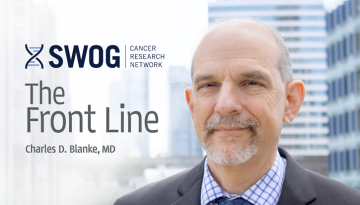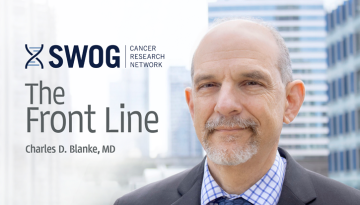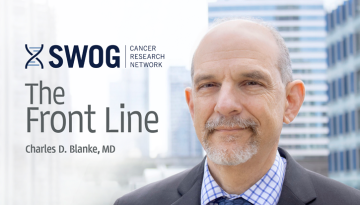Pembro before Surgery Shrinks Advanced Melanomas
In exploratory analyses of results from the SWOG S1801 trial in patients with stage III-IV resectable melanoma, researchers saw a major pathologic response in more than half of surgical specimens taken from patients who had been treated with neoadjuvant (pre-operative) pembrolizumab.
These and other results of the analyses are presented as a proffered paper (Abstract LBA48) at the European Society of Medical Oncology (ESMO) Congress 2023 in Madrid, Spain, on Monday, October 23, by Sapna P. Patel, MD, chair of the SWOG melanoma committee and associate professor of melanoma medical oncology at the University of Texas MD Anderson Cancer Center. Patel is principal investigator of the S1801 trial.
“The pathologic responses seen in S1801 highlight the potential for single-drug immunotherapy to achieve results that we know are important for individual patient outcomes, namely the demonstration of a favorable pathologic response after a few doses of treatment,” Patel said.
“But it is important not to over-interpret the results. The absence of a pathologic response means there is room for improvement, but those patients still likely benefitted from a neoadjuvant approach with immunotherapy where their immune system began priming with tumor in situ than if they had gone to upfront surgery. The goal of a short duration of neoadjuvant immunotherapy is to initiate tumor priming, not necessarily to shrink the tumor(s) or demonstrate pathologic response. Even in the absence of a radiographic or pathologic response, a patient’s immune system may have a more amplified and diversified response after a few doses of pre-operative immunotherapy, and then the tumor can be resected. Soon, we hope to find regimens that are safe and powerful enough where the extent of surgery may even be reduced or avoided.”
Primary results for S1801 were reported at last year’s ESMO Congress and were published in the New England Journal of Medicine in March 2023. They showed that patients with operable stage IIIB through stage IV melanoma who started immunotherapy before surgery had significantly longer event-free survival times than patients who started immunotherapy after their surgery.
The abstract being presented at ESMO 2023 reports results of exploratory analyses of response to neoadjuvant treatment evaluated using specimens removed from these patients during surgery. Specimens were submitted for central review on 78 percent of patients who underwent surgery in the neoadjuvant arm. “This is considered a huge success for clinical trial tissue submission in the cooperative group setting,” Patel added. “We are grateful to sites and investigators for their cooperation.”
To assess pathologic response to a treatment, a pathologist examines tissue removed during surgery to see whether it includes any actively growing cancer cells – known as residual viable tumor. If no active cells are seen, the tissue is said to have undergone a pathologic complete response to treatment. If active cancer cells comprise only 1 percent to 10 percent of the tumor bed, it is said to have undergone a pathologic near-complete response.
“Major pathologic response” is defined as no more than 10 percent residual viable tumor in the examined tissue. It encompasses both the complete response and the near-complete response categories.
It should be cautioned that pathologic response makes assumptions of facts not always in evidence. A pathologist calculates the residual viable tumor (numerator) as a percentage of the total tumor bed (denominator). But the pathologist is not always clear on how large the tumor bed was before initiating neoadjuvant therapy so they are making estimates based on histologic clues, and therefore they could be under-reading response by reading a smaller tumor bed (denominator). There is also the fact that a microscope’s glass slide can only hold a fraction of a bulky lymph node specimen, causing a mathematic artifact if a 5-cm matted lymph node is sectioned across multiple glass slides.
A total of 135 patients in S1801 who received neoadjuvant pembrolizumab subsequently underwent surgery. From these patients, 105 specimens were submitted for central review for pathologic response; the vast majority of these were lymph node specimens. All reviews were performed by Victor G. Prieto, MD, PhD, the Ferenc and Phyllis Gyorkey Chair for Research and Education in Pathology at the University of Texas MD Anderson Cancer Center. At the time of review, Prieto had no information on the clinical outcomes associated with each specimen.
“Particularly interesting was the observation that there was different distribution of response to the treatment (amount of necrosis) among different lesions and even different areas in the same patient,” Prieto said. “This suggests the existence of different tumor phenotypes in the same patient.”
The research team also correlated pathologic response with recurrence-free survival (RFS). They found the rate of RFS at 24 months appeared to segregate by pathologic response, and was at 89 percent for patients whose tumor(s) achieved a pathologic complete response.
SWOG S1801 is supported by the National Cancer Institute (NCI), part of the National Institutes of Health (NIH), led by the SWOG Cancer Research Network, and conducted by the NIH-funded NCI National Clinical Trials Network (NCTN).
S1801 was funded by the NIH/NCI through grants U10CA180888, U10CA180819, U10CA180821, U10CA180868, UG1CA233329, UG1CA233328, UG1CA189860, UG1CA233178, UG1CA233160, UG1CA189821, UG1CA233320, UG1CA233331, UG1CA189850, UG1CA233330, UG1CA233234, UG1CA233180, UG1CA233184, P30CA076292, and P30CA016042 and was supported in part by Merck & Co., Inc., Kenilworth, NJ, USA, through a Cooperative Research and Development Agreement with the NCI.
In addition to Patel, co-authors on the abstract include Megan Othus, SWOG Statistics and Data Management Center; G. Paul Wright, Cancer Research Consortium of West Michigan NCORP/Spectrum Health; John Hyngstrom, University of Utah Huntsman Cancer Institute; Christopher Lao, University of Michigan; Thach-Giao Truong, Kaiser Permanente NCAL, now with Cleveland Clinic Foundation; Sunandana Chandra, Northwestern University; Kari Kendra, Ohio State University Wexner Medical Center; Craig Devoe, Northwell Health Cancer Institute; Aparna Hegde, University of Alabama; Ankit Mangla, University Hospitals Seidman Cancer Center; Michael C. Lowe, Emory University; Elizabeth I. Buchbinder, Dana-Farber Cancer Institute/Harvard Cancer Center; John M. Kirkwood, University of Pittsburgh Medical Center Hillman Cancer Center; Elad Sharon, National Cancer Institute Cancer Therapy Evaluation Program; Larissa Korde, National Cancer Institute Cancer Therapy Evaluation Program; James Moon, SWOG Statistics and Data Management Center; Vernon K. Sondak, Moffitt Cancer Center; Antoni Ribas, UCLA/Jonsson Comprehensive Cancer Center; and Victor G. Prieto, University of Texas MD Anderson Cancer Center. The S1801 study team also included the late Valerie Guild and Samantha Guild, representing the voice of the patient in the development and conduct of the trial.
Reference:
LBA48 – “Pathologic response and exploratory analyses of neoadjuvant-adjuvant versus adjuvant pembrolizumab (PEM) for resectable stage IIIB-IV melanoma from SWOG S1801.” 8:30-8:40, Mon Oct 23, 2023.
(Proffered paper session – Melanoma and other skin tumors, Valencia Auditorium – Hall 10)
https://cslide.ctimeetingtech.com/esmo2023/attendee/confcal/show/session/124
Other Recent Stories



